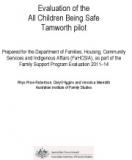Evaluation of the All Children Being Safe Tamworth pilot
Attachments

Aim of publication
This publication presents the evaluation findings of the All Children Being Safe program piloted with primary school children aged five to eight years in the Tamworth region in 2011-12.
The Australian Government provided funding for the All Children Being Safe program pilot developed by the National Association for the Prevention of Child Abuse and Neglect (NAPCAN).
The aims of the pilot were to:
- promote personal safety and resilience in children, young people, and adults, using empowerment strategies, clear communication, and awareness of ‘safe’ behaviours
- reduce violence in the community and prevent child abuse
- promote life-enriching rather than life-depleting experiences
- encourage people to assert their right to feel safe, listen to what their body tells them, follow up by taking action to either solve problems on their own or to seek assistance from other people.
FaHCSIA commissioned an evaluation of the pilot, undertaken by the Australian Institute of Family Studies in 2012. The evaluation looks at how well the pilot meets its aims by using an outcomes and process approach. The evaluation findings will inform future policy around Protective Behaviour programs.
Who is it for?
The evaluation of the All Children Being Safe Tamworth Pilot is for Commonwealth, state and territory governments, non‑government organisations, service providers and individuals with an interest in ensuring Australia’s children are safe and well.
What does it cover?
The All Children Being Safe (ACBS) program is an early primary school program designed to increase students’ awareness and skills about personal safety. A pilot of the program was conducted in schools between July 2011 and June 2012 in the Tamworth NSW region by Centacare New England North West. A total of 1950 children from 15 public primary schools participated in the pilot.
The evaluation examines whether the All Children Being Safe program was effective at engaging children and increasing their knowledge of protective behaviours and whether the program could be improved or enhanced in the future.
Last updated:
